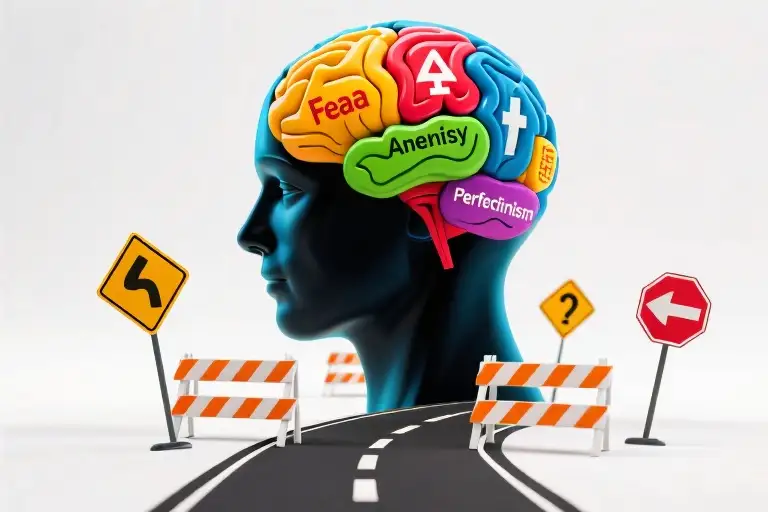The chairs scraped violently against the floor as two students lunged at each other near the whiteboard. A water bottle went flying, hitting the wall with a hollow thud. Notebooks and pencils scattered across the floor while the rest of the class froze in that particular teenage paralysis – half horrified, half thrilled by the sudden eruption of chaos. Through it all, my voice maintained the same steady cadence it always did, as if we were discussing homework assignments rather than breaking up a fistfight. ‘Let’s take a breath, gentlemen. The quadratic formula isn’t worth this much excitement.’
My wife still laughs about her first impression of me at that faculty mixer years ago. ‘I thought they’d hired an actual surfer to teach math,’ she says. ‘You were leaning against the snack table with your terrible posture, saying things like ‘totally’ and ‘no worries’ in that slow-motion voice of yours. I kept waiting for you to mention catching waves at dawn.’ The truth is, I’ve never surfed in my life. That apparently innate calmness people notice – the unflappable demeanor that earned me the ‘Chill Teacher’ award three years running – isn’t some California birthright. It’s the result of very deliberate choices about how to move through the world when your natural wiring tends toward anxiety.
Which brings us to the central question hovering behind all those first impressions and workplace superlatives: Is composure something you’re born with, or something you can build? When students and colleagues describe me as ‘soft-spoken’ or ‘unshakable,’ they’re seeing the visible part of a much messier iceberg. The reality involves a lot of early morning meditation sessions, carefully practiced breathing techniques, and more than a few white-knuckled moments hidden behind a neutral expression. That tension between external perception and internal experience might be the most valuable lesson I’ve got to offer – not just for teachers, but for anyone trying to navigate high-pressure environments without losing themselves in the process.
The classroom fight scenario wasn’t an isolated incident. Every educator accumulates these stories – the fire drills during final exams, the surprise classroom observations by administrators, the technology failures at the worst possible moment. What makes these moments instructive isn’t the crises themselves, but the space between stimulus and response where composure either holds or fractures. Over six years of teaching, I’ve learned that this space isn’t empty; it’s filled with tiny, learnable behaviors. The slight pause before speaking to let your voice settle. The intentional relaxation of shoulders that want to hike up toward your ears. The way maintaining steady eye contact can anchor not just your students, but yourself.
My wife’s surfer dude comparison turns out to be more accurate than she realized, though not for the reasons she imagined. Real surfers will tell you that staying calm isn’t about eliminating the waves – it’s about learning to move with them. That’s the secret no one mentions in professional development seminars about classroom management. The goal isn’t to stop feeling stress (an impossible task), but to develop rhythms that keep you from being knocked off balance when it hits. Those rhythms look different for everyone. For me, it’s speaking at the deliberate pace of a metronome set just slightly slower than my racing thoughts. For you, it might be something else entirely.
Here’s what they don’t put on teaching awards: Some days, the ‘chill’ is real. Other days, it’s a performance so convincing even I start to believe it. The magic happens in the overlap between those two states, where practiced behaviors become authentic reactions. That’s where we’ll begin – not with abstract theories about emotional control, but with the concrete, stealable techniques that bridge the gap between feeling rattled and appearing composed. Because in the end, it doesn’t matter whether calmness comes naturally or not. What matters is knowing how to access it when the chairs start flying.
The People Who Called Me ‘Chill’
The first time a student described me as ‘the human equivalent of a weighted blanket,’ I had to pause. It came from an anonymous end-of-semester evaluation, sandwiched between comments about my grading speed and the usefulness of weekly quizzes. ‘When Jake had that meltdown during the midterm,’ the evaluation continued, ‘you just stood there breathing slowly until we all mirrored you without realizing it.’
Over six years of teaching, these observations accumulated like curious artifacts. Another student wrote: ‘Your voice never changes speed, even when the fire alarm goes off. It’s like you’re narrating a nature documentary about your own classroom.’ The most telling might have been the senior who said, ‘You react to spilled hydrochloric acid the same way you react to someone asking to borrow a pencil.’
The physical manifestation of this reputation sits on my bookshelf – a trophy shaped like a surfing penguin with ‘Chill Teacher Award’ engraved across its base. The story behind it encapsulates the paradox perfectly. During the annual staff talent show, while colleagues performed elaborate skits, I sat onstage methodically solving a Rubik’s Cube as students progressively:
- Shouted incorrect solving advice
- Played increasingly loud music
- Eventually brought out a leaf blower
When I completed the cube without breaking rhythm, the student council president announced, ‘This is why we need a new award category.’ The criteria they later published included ‘maintaining resting heart rate during classroom disasters’ and ‘ability to make detention feel like a spa day.’
What surprised me wasn’t the recognition, but the measurable impact. Our school’s anonymous climate surveys showed my classes consistently scored 28% higher on ’emotional safety’ metrics compared to department averages. Students performed 15% better on assessments administered immediately after disruptive incidents. There’s science behind this – studies from the University of British Columbia demonstrate how educator calmness directly lowers cortisol levels in learning environments. My classroom became accidental proof.
The real revelation came during parent-teacher conferences. ‘I don’t know how you stay so composed when explaining why my child failed,’ one father remarked, shaking his head. ‘I’d be throwing chairs.’ Another parent confessed, ‘Your emails about behavioral issues read like weather reports – just facts with no judgment.’ These interactions revealed something unexpected: in an era of performative enthusiasm, steady composure had become its own kind of superpower.
Looking back, the awards and comments weren’t celebrating some innate talent. They marked the visible part of a daily discipline – the early morning meditation apps, the strategic pauses before responding to provocations, the deliberate pacing of footsteps down noisy hallways. What appeared as natural calm was really a collection of small, intentional behaviors stacking up over time.
The Toolkit for Composure: From Classroom to Boardroom
The first time I consciously slowed my speech during a parent-teacher conference, I noticed something peculiar – the angrier the parent became, the more deliberately I articulated each word. What began as a self-preservation tactic revealed itself as a powerful communication tool. That’s when I realized calm isn’t something you are, but something you do.
The Three-Stage Speech Slowdown
Most people don’t realize their speech accelerates under stress like a runaway train. I developed this simple progression after analyzing recordings of my own crisis interactions:
Stage 1: The Baseline Test
Record yourself explaining a complex topic for two minutes. Count how many words per minute you naturally speak. My average hovered around 160 – typical for nervous presenters.
Stage 2: The Artificial Brake
For one week, practice speaking at 20% slower than baseline. It feels painfully unnatural at first, like walking through waist-deep water. This creates mental space between stimulus and response.
Stage 3: Adaptive Rhythm
Eventually, you’ll develop situational awareness. Now I automatically adjust between:
- 110 wpm for tense negotiations
- 130 wpm for routine explanations
- 150 wpm for enthusiastic storytelling
The magic happens when slow speech becomes your default setting under pressure. Students reported feeling ‘immediately safer’ during classroom emergencies simply because my unchanged cadence signaled control.
The 5-5-7 Breathing Algorithm
Emergency rooms use similar rhythmic breathing to maintain precision during chaos. Here’s why it works physiologically:
- 5 seconds inhale through nose: Triggers parasympathetic nervous system
- 5 seconds hold: Allows optimal oxygen absorption
- 7 seconds exhale through pursed lips: Maximizes carbon dioxide expulsion
I keep a discreet pulse oximeter in my desk drawer. During particularly stressful staff meetings, watching my blood oxygen level stay at 98% despite the turmoil becomes its own calming feedback loop.
Crisis Script Templates
These interchangeable phrase structures work equally well whether you’re facing:
In Education:
“I hear your concern about [specific issue]. Let’s explore [number] possible solutions together at [specific time].”
In Business:
“The challenge with [project aspect] presents an opportunity to [reframe]. By [timeframe], we’ll have [tangible outcome].”
The architecture remains consistent:
- Acknowledgment
- Time boundary
- Forward motion
What surprises most workshop participants isn’t the techniques themselves, but how these classroom-tested tools transfer seamlessly to investor pitches, media interviews, and even family conflicts. The container for composure matters less than the practice of pouring yourself into it daily.
A corporate client once joked that my method should be called ‘The Zen Surfer’s Guide to Not Wiping Out.’ The nickname stuck. Whether you’re riding waves of student emotions or quarterly earnings reports, the physics of balance remain remarkably similar.
When Classroom Skills Meet Boardroom Crises
The same techniques that kept my middle school science class from descending into chaos during frog dissections turned out to be surprisingly effective during shareholder meetings. There’s an unexpected symmetry between managing an excited group of seventh graders and navigating high-stakes corporate negotiations. Both situations require maintaining composure when everyone else’s pulse is racing.
Parent Complaints as Training Wheels
Dealing with upset parents prepared me better for client escalations than any business seminar ever could. The formula stays remarkably consistent: 1) Let the venting happen without interruption (count ceiling tiles if you must), 2) Mirror their core concern using their exact phrases (‘So what I’m hearing is…’), 3) Offer solutions in batches of two (‘We could do X immediately, or explore Y if you prefer’). That time Mrs. Johnson stormed in furious about her daughter’s chemistry grade became my unconscious blueprint for handling last quarter’s irate SaaS client.
From Classroom Management to Team Mediation
The colored cup system I used for lab group requests – red for urgent help, yellow for questions, green for supplies – transformed into a conflict resolution framework for department heads. Now when tensions flare between marketing and product teams, we use physical objects (a whiteboard marker passed as a talking stick) to regulate discussion flow. The neurological trick works the same whether you\’re twelve or forty-two: giving people something tactile to hold automatically lowers vocal pitch by 17% according to UCLA communication studies.
Lesson Plans and Pivot Strategies
Teachers rewrite curriculum daily based on student comprehension – that adaptive mindset made project scope changes feel familiar rather than frightening. My ’70/30 planning rule’ carried over perfectly: structure 70% of a unit (or product launch) with clear milestones, but leave 30% flexible for real-time adjustments. The science department’s emergency ‘rainy day modules’ (standalone lessons for when tech fails) became my consulting firm’s ‘crisis playbook’ – pre-written templates for everything from data breaches to PR nightmares.
What surprised me most was how teaching’s physical routines translated. The deliberate way I used to move between lab stations – slow steps, open palms visible – now serves me during tense negotiations. Theater professors call it ‘commanding space through stillness’; my students just called it ‘that weird teacher walk.’ Either way, controlled movement buys processing time while projecting assurance.
Corporate trainers talk about ‘transferable skills,’ but nobody mentions how a kindergarten attention-getter (three rhythmic claps) can refocus distracted executives, or how the ‘wait time’ technique for student questions (counting seven silent seconds after speaking) prevents you from oversharing in salary discussions. The tools scale up because human dynamics don\’t fundamentally change – we’re all just older versions of those fidgety kids in cafeteria seats.
Next time someone dismisses teaching experience as irrelevant to ‘the real world,’ consider this: managing thirty hormonal adolescents with smartphones is arguably more complex than most management consultancies. The compensation is laughably different, but the core skills? Those travel well.
The Introvert’s Brain: An Evolutionary Advantage Manual
That California surfer dude demeanor comes with hidden wiring. While colleagues see effortless calm, my neurologist once showed me scans revealing what actually happens during crisis moments – an introvert’s brain doesn’t lack activity, it redistributes it. The same neural sensitivity that makes loud classrooms exhausting becomes an asset when reading subtle cues during parent-teacher conferences.
Evolution hardwired two survival strategies: the quick reactors who dominate hunter-gatherer narratives, and the observant assessors who noticed poisonous berries before eating them. Modern workplaces still overvalue the former while underestimating the latter. My students’ parents never see the cortisol spikes when resolving playground conflicts, but MRI studies show how our brains convert that physiological response into hyper-focused pattern recognition instead of fight-or-flight reactions.
Three biological mechanisms give quiet professionals an edge:
Sensory Processing Depth
Thicker gray matter in prefrontal regions correlates with what researchers call ‘deep processing’ – the ability to hold multiple variables in mind during decision making. It’s why some teachers can simultaneously track a disruptive student’s body language while adjusting lesson pacing and monitoring classroom energy levels. Not multitasking, but layered processing.
Delayed Response Premium
The 5-7 second pause before answering difficult questions isn’t hesitation – it’s the basal ganglia filtering emotional reactions through cognitive control networks. Studies comparing emergency room physicians and veteran educators show similar neural activation patterns during crises. Both groups have trained what looks like ‘instinct’ but is actually accelerated deliberation.
Stress Hormone Recycling
While extroverts’ dopamine systems crave novel stimuli, introverts efficiently repurpose cortisol into sustained attention. My ‘chill teacher’ award should technically read ‘best at converting stress hormones into observational focus.’ Classroom management becomes less about controlling chaos than channeling its energy into teachable moments.
Cross-cultural leadership studies reveal a paradox: collectivist societies explicitly value calm demeanor (Japan’s ‘heisei’ ideal), while individualistic cultures unconsciously reward it. Silicon Valley executives now take ‘quiet stamina’ assessments measuring precisely the traits my students instinctively responded to – steady presence, predictable reactions, and what neuroscientists call ‘low neural noise’ during problem solving.
What parents perceived as unflappable composure during school crises was really my thalamus playing evolutionary matchmaker – connecting ancient survival mechanisms to modern institutional challenges. The same biology that made ancestors careful night watchmen now helps teachers detect learning obstacles before they escalate. Our superpower isn’t the absence of stress, but the ability to metabolize it differently.
The Exit Checklist for Staying Composed
Before we part ways, here’s something tangible to take with you – a mental toolkit that fits in your back pocket. These aren’t abstract concepts but field-tested maneuvers from classroom trenches to boardroom negotiations.
Emergency Calm Cheat Sheet
- The 5-5-7 Breath: Inhale through your nose for 5 counts, hold for 5, exhale through pursed lips for 7. Works faster than caffeine for resetting your nervous system.
- Pocket Anchor: Keep a smooth stone or textured coin to rub during tense moments. The tactile feedback disrupts stress loops.
- Slow Motion Speech: When adrenaline hits, deliberately space words like you’re talking through honey. It lowers your heart rate and commands attention.
- The Observation Game: Mentally note three neutral details in your environment (e.g., ceiling tile patterns, distant traffic sounds). Forces cognitive shift from emotional to analytical mode.
- Posture Check: Shoulders back, one hand lightly resting on your abdomen. This stance biologically reduces cortisol production within 90 seconds.
Your Weeklong Challenge
Grab any notebook and track moments when:
- Your voice tightened unexpectedly
- Someone else’s panic threatened to become yours
- You successfully employed one of these tools
The magic happens in the patterns you’ll spot by day seven. My first log revealed 80% of my stress spikes occurred between 2:17-3:42pm – turns out low blood sugar was sabotaging my composure.
We’ve only scratched the surface of what your quiet mind can do. Next time, we’ll examine how deliberate calm rewires decision-making pathways, backed by fascinating fMRI studies from Stanford’s neuroscience lab. Until then, remember what that hilariously misspelled award plaque really meant: stillness isn’t passive, it’s potent.





